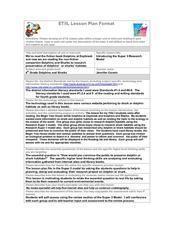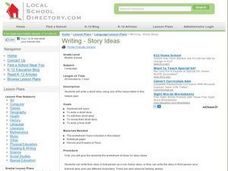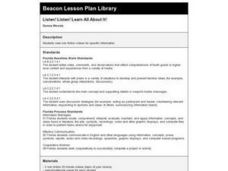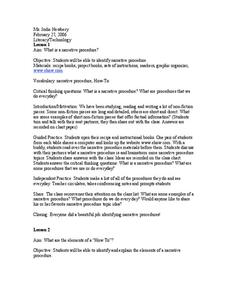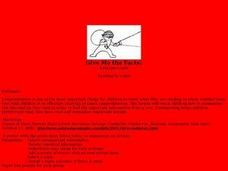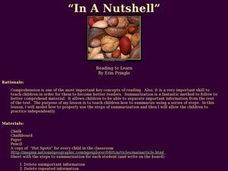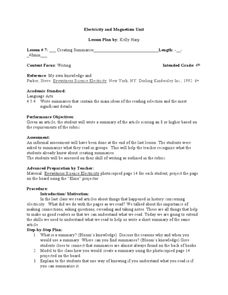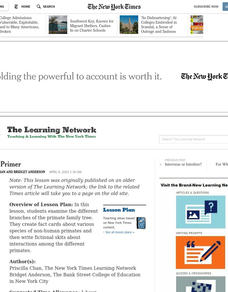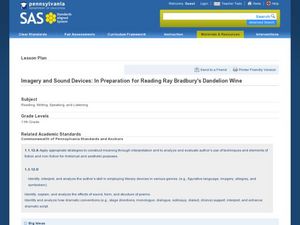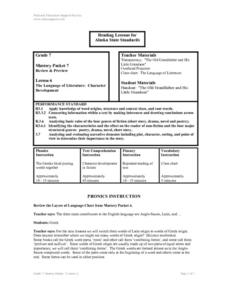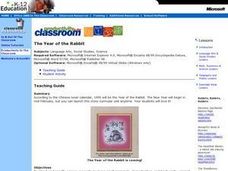Curated OER
Introducing the Super 3 Research Model
Fourth graders read the fiction selection, Dolphins at Daybreak, and then the corresponding non-fiction books about dolphins and sharks. They use a specific research model to find information about dolphins and sharks from books and...
Curated OER
Writing - Story Ideas
Students write their story in first person as a non-fiction story, or they can write the story in third person as a fictional story and use different characters. They can choose an idea from one of the story starters provided.
Curated OER
Listen! Listen! Learn All About It!
Fourth graders view non-fiction videos. They write questions that can be answered with information in the video. Every 10 minutes the video is stopped and the class discusses the questions.
Curated OER
George Washington
First graders gain background knowledge about George Washington. They visit a website to find out additional information. Students create a web on chart paper of his important events, write a non fiction book about hima nd share their...
Curated OER
Familiarization Fun: Using the Media Center
Students participate in a scavenger hunt to locate the different sections of the media center and determine the purpose for each section. They build a jigsaw puzzle as they find each major section of the library such as the reference or...
Curated OER
Narrative Procedure
Students identify narrative procedure. In this narrative procedure lesson, students analyze a recipe and visit the website www.ehow.com. Students discuss narrative procedures and answer questions. students make a list of the procedures...
Curated OER
Independent - To Be or Not Top Be - Day 1, Lesson B: To Arms!
Fifth graders explore the verbal and non-verbal parts of an oral presentation.
Curated OER
Let's Sum It All Up
Fourth graders watch a modeled lesson on summarizing the main ideas of a non-fiction passage. They silently read a passage about sharks before making a class summarization chart. Next, they read a small passage and summarize it...
Curated OER
Give Me the Facts!
Pupils study how to summarize a reading passage to improve their comprehension. They read a non-fiction passage and use five steps to summarize it while working in groups of three. Next, as class, they decide which group provided the...
Curated OER
Strength in Summarizing
Third graders practice summarizing passages while creating a fishbone map of important details in non-fiction text. They examine how to tell the difference between important and less important details by highlighting them in reading...
Curated OER
Putting It All Together With Summarization
Learners use a checklist to write a summary of a non-fiction article. The checklist includes: redundant information taken out, trivial information taken out, and only main points included in the summary. Using this checklist, they ...
Curated OER
In a Nutshell
Students summarize a non-fiction article in this lesson. They review a six step process for summarization. They then read the assigned article, and work as a class to write a summary using the five steps provided. They then write an...
Curated OER
Columbus in a Summary
Students summarize a non-fiction selection in this lesson. Students review the rules of summarization: delete trivial information, delete repeated information, superordinate items and events, and find or compose statements that covers...
Curated OER
Animal Artists
Students read a current events non-fiction article and answer vocabulary and comprehension questions about it. In this animal artists paint for fun lesson plan, students also work on dictionary skills, geography, and creative thinking by...
Curated OER
Creating Summaries
Fourth graders generate written summaries from non-fiction articles. In this writing lesson plan, 4th graders determine what must be included in writing a good summary and then work in small groups to construct summaries after...
Curated OER
Media Literacy
Students evaluate the effectiveness of Internet book clubs, present their findings to the class, and design their own on-line book club (under the umbrella of a fictional television program) to encourage non-readers to read more.
Curated OER
Discovering Ourselves in Literature and Life
Students read literature and view other media to discover how print and non-print texts answer the thematic question: Who am I? students compare the ways ideas are presented, and create their own portfolios or personal Web pages...
Curated OER
Primate Primer
Students examine the different branches of the primate family tree. They create fact cards about various species of non-human primates and then write fictional skits about interactions among the different primates.
Curated OER
I, Robot: Chapter One
Students discuss literature about technology in the 20th century. In this book study lesson, students read I, Robot by Isaac Asimov and compare the fiction to technology in the 20th century.
Curated OER
Imagery and Sound Devices: In Preparation for Reading Ray Bradbury's Dandelion Wine
Twelfth graders analyze Ray Bradbury's use of techniques and elements of fiction as well as nonfiction in the novel Dandelion Wine. In this novel analysis lesson, 12th graders analyze the sensory techniques in Dandelion Wine. Students...
Curated OER
Parts of a Story
Students read a short fiction book and demostrate comprehension by identifying the main characters, setting, conflict, theme, and summarizing the main points. They organize the information in Inspiration and create a powerpoint to show...
Curated OER
Greek Origins and Character Development
Seventh graders examine words of Greek origin and discuss character development in fiction. They read a list of Greek word parts and create words on a worksheet. Students then read and discuss an informational handout about character...
Curated OER
Go For The Gold!
Third graders read fiction and nonfiction works for comprehension. Using the internet, 3rd graders participate in a WebQuest. They compare and contrast the Olympics in ancient Greece to the modern day Olympics. Afterwards, students...
Curated OER
The Year of the Rabbit
Students explore a portion of the Chinese Zodiac with projects centered around the year of the rabbit. Students research types of rabbits, actual and fictional. Working in groups, they create a written or multimedia presentation.
Other popular searches
- Non Fiction Text Features
- Non Fiction Writing
- Non Fiction Reading Passages
- Non Fiction Text
- Non Fiction Reading
- Non Fiction Reading
- Non Fiction Text Features
- Creative Non Fiction
- Fiction Non Fiction
- Elements of Non Fiction
- Fiction and Non Fiction
- Non Fiction Graphic Organizer
